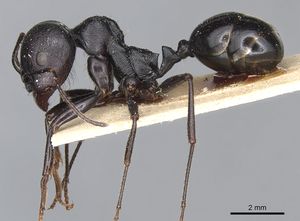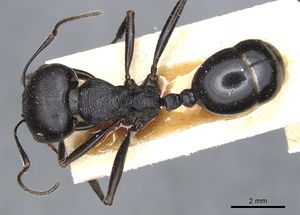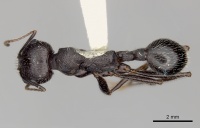Messor arenarius
| Messor arenarius | |
|---|---|

| |
| Scientific classification | |
| Kingdom: | Animalia |
| Phylum: | Arthropoda |
| Class: | Insecta |
| Order: | Hymenoptera |
| Family: | Formicidae |
| Subfamily: | Myrmicinae |
| Tribe: | Stenammini |
| Genus: | Messor |
| Species: | M. arenarius |
| Binomial name | |
| Messor arenarius (Fabricius, 1787) | |
| Subspecies | |
| |
| Synonyms | |
| |
Identification
Collingwood and Agosti (1996) - HW 3.4-4.5; EL/HW 0.165. This is by far the largest Messor species in the Middle East. The subcephalic hairs are numerous but do not form a distinct psammophore. All body surfaces are covered with erect hairs. The propodeum is armed with short strong spines. The general body colour is brownish black but the alitrunk is occasionally somewhat reddish and such examples appear little different from Messor regalis of sub-Saharan Africa, sharing the same features: short first funiculus segment, pectinate tibial spurs, thick body pilosity, spined propodeum and rugose body sculpture extending to the first gastral tergite.
Keys including this Species
Distribution
Latitudinal Distribution Pattern
Latitudinal Range: 35.85° to 24.633333°.
| North Temperate |
North Subtropical |
Tropical | South Subtropical |
South Temperate |
- Source: AntMaps
Distribution based on Regional Taxon Lists
Afrotropical Region: Saudi Arabia.
Palaearctic Region: Algeria, Israel, Kuwait, Tunisia (type locality).
Distribution based on AntMaps
Distribution based on AntWeb specimens
Check data from AntWeb
Countries Occupied
| Number of countries occupied by this species based on AntWiki Regional Taxon Lists. In general, fewer countries occupied indicates a narrower range, while more countries indicates a more widespread species. |

|
Estimated Abundance
| Relative abundance based on number of AntMaps records per species (this species within the purple bar). Fewer records (to the left) indicates a less abundant/encountered species while more records (to the right) indicates more abundant/encountered species. |

|
Biology
Castes
Worker
Images from AntWeb
   
| |
| Type of unavailable quadrinomial: Messor barbarus striativentris beduinus. Worker. Specimen code casent0904137. Photographer Will Ericson, uploaded by California Academy of Sciences. | Owned by MSNG, Genoa, Italy. |
Nomenclature
The following information is derived from Barry Bolton's Online Catalogue of the Ants of the World.
- arenarius. Formica arenaria Fabricius, 1787: 310 (w.) (no state data, “Habitat in Ba(r)bariae”).
- Type-material: 3 syntype workers.
- Type-locality: “Barbaria” (= North African coast from Morocco to Libya).
- Type-depositories: ZMUC, ZMUK.
- [Note: Zimsen, 1964: 426, reports 2 specimens in ZMUC, 1 in ZMUK.]
- André, 1883b: 366 (q.); Emery, 1891b: 12 (q.m.); Forel, 1902a: 148 (m.).
- Combination in Aphaenogaster: Roger, 1863b: 29;
- combination in Atta: Mayr, 1863: 395;
- combination in Aphaenogaster (Messor): Forel, 1890a: lxx; Forel, 1894d: 28;
- combination in Stenamma (Messor): Emery, 1898c: 125;
- combination in Cratomyrmex: Cagniant, 1970a: 414;
- combination in Messor: Emery, 1908e: 439; Bolton, 1995b: 252.
- Status as species: Gmelin, 1790: 2802; Olivier, 1792: 499; Latreille, 1802c: 288; Fabricius, 1804: 411; Roger, 1862c: 292; Roger, 1863b: 29; Mayr, 1863: 395; Emery, 1880: 392; Emery, 1881b: 534; André, 1881b: 74; André, 1883b: 353 (in key); Emery, 1884a: 382; Forel, 1890a: lxx; Emery, 1891b: 12; Dalla Torre, 1893: 98; Forel, 1894d: 28; Forel, 1895d: 233; Emery, 1898c: 125; Forel, 1902a: 148; Forel, 1904c: 5; Forel, 1907e: 15; Forel, 1908a: 14; Emery, 1908e: 439 (redescription); Forel, 1909e: 379; Karavaiev, 1911: 3; Karavaiev, 1912a: 5; Forel, 1913d: 428; Stitz, 1917: 342; Crawley, 1920a: 163; Emery, 1921f: 69; Emery, 1924a: 7; Menozzi, 1927g: 379; Kutter, 1928: 66; Finzi, 1930b: 15; Santschi, 1931a: 4; Menozzi, 1932e: 452; Menozzi, 1933b: 51; Menozzi, 1934: 158; Finzi, 1936: 158; Santschi, 1938a: 32 (redescription); Menozzi, 1940: 267; Finzi, 1940: 158; Cagniant, 1964: 87; Cagniant, 1968a: 143; Cagniant, 1970a: 414; Bernard, 1971: 6; Collingwood, 1985: 249; Kugler, J. 1988: 257; Bolton, 1995b: 252; Collingwood & Agosti, 1996: 316; Cagniant & Espadaler, 1998: 423; Cagniant, 2006a: 197; Vonshak, et al. 2009: 42; Borowiec, L. 2014: 102 (see note in bibliography); Tohmé, G. & Tohmé, 2014: 134; Barech, et al. 2020: 14.
- Senior synonym of amaurocyclia: Roger, 1862c: 292; Mayr, 1863: 395; Roger, 1863b: 29; Dalla Torre, 1893: 98; Emery, 1921f: 69; Bolton, 1995b: 252.
- Senior synonym of beduinus: Cagniant, 2006a: 197; Barech, et al. 2020: 14.
- Senior synonym of bugnioni: Forel, 1904f: 424; Emery, 1908e: 439; Emery, 1921f: 69; Bolton, 1995b: 252.
- Senior synonym of scalpturata: Roger, 1862c: 292; Mayr, 1863: 395; Roger, 1863b: 29; Dalla Torre, 1893: 98; Emery, 1921f: 69; Bolton, 1995b: 252.
- Distribution: Algeria, Egypt, Iran, Israel, Kuwait, Lebanon, Libya, Morocco, Saudi Arabia, Syria, Tunisia.
- Current subspecies: nominal plus alfierii, diabolus, ratus, thebaicus.
- amaurocyclia. Myrmica amaurocyclia Foerster, 1850b: 486 (w.) ALGERIA.
- Type-material: syntype workers (number not stated).
- Type-locality: Algeria: Algiers (no collector’s name).
- Type-depository: MNHU (Horn & Kahle, 1935: 78).
- [Note: perhaps type-material is also in MNHN as Foerster (p. 486) thanks “Leon Fairmaire in Paris” for the specimens.]
- Combination in Aphaenogaster: Roger, 1863b: 29.
- Junior synonym of arenarius: Roger, 1862c: 292; Mayr, 1863: 395; Roger, 1863b: 29; Dalla Torre, 1893: 98; Emery, 1921f: 69; Bolton, 1995b: 252.
- beduinus. Messor barbarus st. beduinus Emery, 1922c: 93.
- Type-material: syntype workers (number not stated).
- Type-locality: Tunisia: Kairouan (F. Santschi).
- Type-depository: MSNG.
- [First available use of Messor barbarus subsp. striativentris var. beduina Emery, 1908e: 453 (w.) TUNISIA; unavailable (infrasubspecific) name.]
- Santschi, 1910a: 45 (q.); Santschi, 1926e: 234 (m.).
- As unavailable (infrasubspecific) name: Santschi, 1910a: 45; Emery, 1921f: 72.
- Subspecies of barbarus: Emery, 1924a: 7; Kutter, 1928: 66.
- Status as species: Santschi, 1923a: 134; Santschi, 1923f: 320 (in text); Menozzi, 1934: 158; Finzi, 1940: 156; Bolton, 1995b: 252; Borowiec, L. 2014: 102 (error).
- Junior synonym of arenarius: Cagniant, 2006a: 197; Barech, et al. 2020: 14.
- bugnioni. Stenamma (Messor) bugnioni Forel, 1904c: 13 (w.) ALGERIA.
- Type-material: holotype worker.
- Type-locality: Algeria: Biskra (Bugnion).
- Type-depository: MHNG.
- Junior synonym of arenarius: Forel, 1904f: 424; Emery, 1908e: 439; Emery, 1921f: 69; Bolton, 1995b: 253.
- scalpturata. Myrmica scalpturata Nylander, 1856b: 83 (w.) ALGERIA, EGYPT.
- Type-material: syntype workers (number not stated), 1 syntype queen.
- Type-localities: Algeria, Egypt (no further data).
- Type-depository: ZMHF.
- [Note: Nylander mentions that the specimens originated in the collections of Sichel and Fairmaire, both of which are in MNHN.]
- Combination in Atta: Smith, F. 1858b: 165; Roger, 1859: 252;
- combination in Aphaenogaster: Roger, 1863b: 29.
- Status as species: Smith, F. 1858b: 165; Roger, 1859: 252.
- Junior synonym of arenarius: Roger, 1862c: 292; Mayr, 1863: 395; Roger, 1863b: 29; Dalla Torre, 1893: 98; Emery, 1921f: 69; Bolton, 1995b: 257.
Description
References
- André, E. 1883b. Les fourmis. [concl.]. Pp. 345-404 in: André, Edm. 1881-1886. Species des Hyménoptères d'Europe et d'Algérie. Tome Deuxième. Beaune: Edmond André, 919 + 48 pp. (page 366, queen described)
- Atanackovic, V. 2013. Understanding contraints and potentials of weed management through seed predation by harvester ants (unpublished Ph.D. thesis).
- Barech, G., Khaldi, M., Espadaler, X., Cagniant, H. 2020. Révision taxonomique du genre Messor (Hymenoptera, Formicidae) au Maghreb et description de Messor hodnii sp. n., une nouvelle espèce de fourmi trouvée en Algérie. Revue suisse de Zoologie 127(1) : 9-19 (doi:10.35929/RSZ.0002).
- Borowiec, L. 2014. Catalogue of ants of Europe, the Mediterranean Basin and adjacent regions (Hymenoptera: Formicidae). Genus (Wroclaw) 25(1-2): 1-340.
- Cantone S. 2018. Winged Ants, The queen. Dichotomous key to genera of winged female ants in the World. The Wings of Ants: morphological and systematic relationships (self-published).
- Collingwood, C. A. and D. Agosti. 1996. Formicidae (Insecta: Hymenoptera) of Saudi Arabia (part 2). Fauna Saudi Arabia. 15:300-385.
- Emery, C. 1891c. Exploration scientifique de la Tunisie. Zoologie. - Hyménoptères. Révision critique des fourmis de la Tunisie. Paris: Imprimerie Nationale, iii + 21 pp. (page 12, queen, male described)
- Emery, C. 1898c. Beiträge zur Kenntniss der palaearktischen Ameisen. Öfvers. Fin. Vetensk.-Soc. Förh. 20: 124-151 (page 125, Combination in Stenamma (Messor))
- Emery, C. 1908f. Beiträge zur Monographie der Formiciden des paläarktischen Faunengebietes. (Hym.) Teil III. Dtsch. Entomol. Z. 1908: 437-465 (page 439, Combination in Messor)
- Fabricius, J. C. 1787. Mantissa insectorum sistens eorum species nuper detectas adiectis characteribus, genericis, differentiis, specificis, emendationibus, observationibus. Tome I. Hafniae [= Copenhagen]: C. G. Proft, 348 pp. (page 310, worker described)
- Fernández-Escudero, I., Tinaut, A. 1998. Heat-cold dialectic in the activity of Proformica longiseta, a thermophilous ant inhabiting a high mountain (Sierra Nevada, Spain). International Journal of Biometeorology 41, 175–182 (doi:10.1007/s004840050072).
- Forel, A. 1890b. Fourmis de Tunisie et de l'Algérie orientale. Ann. Soc. Entomol. Belg. 34:lxi-lxxvi. (page lxx, Combination in A. (Messor))
- Forel, A. 1894d. Les Formicides de la Province d'Oran (Algérie). Bull. Soc. Vaudoise Sci. Nat. 30: 1-45 (page 45, Combination in Messor)
- Forel, A. 1902a. Les fourmis du Sahara algérien récoltées par M. le Professeur A. Lameere et le Dr. A. Diehl. Ann. Soc. Entomol. Belg. 46: 147-158 (page 148, male described)
- Forel, A. 1904g. Dimorphisme du mâle chez les fourmis et quelques autres notices myrmécologiques. Ann. Soc. Entomol. Belg. 48: 421-425 (page 424, Senior synonym of bugnioni)
- Horna-Lowell, E., Neumann, K.M., O’Fallon, S., Rubio, A., Pinter-Wollman, N. 2021. Personality of ant colonies (Hymenoptera: Formicidae) – underlying mechanisms and ecological consequences. Myrmecological News 31: 47-59 (doi:10.25849/MYRMECOL.NEWS_031:047).
- O’Donnell, S., Bulova, S., Caponera, V., Oxman, K., Giladi, I. 2020. Species differ in worker body size effects on critical thermal limits in seed-harvesting desert ants (Messor ebeninus and M. arenarius). Insectes Sociaux (doi:10.1007/s00040-020-00782-5).
- Plowes, N.J.R., Johnson, R.A., Holldobler, B. 2013. Foraging behavior in the ant genus Messor (Hymenoptera: Formicidae: Myrmicinae). Myrmecological News 18, 33-49.
- Roger, J. 1862c. Synonymische Bemerkungen. 1. Ueber Formiciden. Berl. Entomol. Z. 6: 283-297 (page 292, Senior synonym of amaurocyclia and scalpturata)
- Roger, J. 1863b. Verzeichniss der Formiciden-Gattungen und Arten. Berl. Entomol. Z. 7(B Beilage: 1-65 (page 29, Combination in Aphaenogaster)
- Ruano, F., Tinaut, A., Soler, J.J. 2000. High surface temperatures select for individual foraging in ants. Behavioral Ecology 11, 396-404.
- Santschi, F. 1938a [1937]. Quelques nouvelles fourmis d'Egypte. Bull. Soc. Entomol. Egypte 21: 28-44 (page 32, see also)
- Sharaf, M.R., Abdel-Dayem, M.S., Mohamed, A.A., Fisher, B.L., Aldawood, A.S. 2020. A preliminary synopsis of the ant fauna (Hymenoptera: Formicidae) of Qatar with remarks on the zoogeography. Annales Zoologici 70: 533-560 (doi:10.3161/00034541anz2020.70.4.005).
- Warburg, I., Steinberger, Y. 1997. On the spatial distribution of nests of the ants Messor arenarius and Messor ebeninus. Journal of Arid Environments 36: 671-676.
References based on Global Ant Biodiversity Informatics
- Abdul-Rassoul M. S., H. A. Dawah, and N. Y. Othman. 1978. Records of insect collection (Part I) in the natural history research centre, Baghdad. Bull. Nat. Hist. Res. Centre 7(2): 1-6.
- Alfieri A. 1931. Contribution à l'étude de la faune myrmécologique de l'Egypte. Bulletin. Société Entomologique d'Egypte 15: 42-48.
- Barech G., M. Khaldi, S. Ziane, A. Zedam, S. Doumadji, M. Sharaf, and X. Espadaler. 2016. A first checklist and diversity of ants (Hymenoptera: Formicidae) of the saline dry lake Chott El Hodna in Algeria, a Ramsar Conservation Wetland. African Entomology 24(1): 143–152.
- Ben Mordechai J., and J. Kugler. 1976. Ecology of ants in the desert loess plain (Sede Zin) of Sede Boqer (Central Negev). Israel Journal of Zoology 25: 216-217.
- Borowiec L. 2014. Catalogue of ants of Europe, the Mediterranean Basin and adjacent regions (Hymenoptera: Formicidae). Genus (Wroclaw) 25(1-2): 1-340.
- Cagniant, H. 1968. Liste preliminaire de fourmis forestieres d'Algerie. Resultats obtenus de 1963 a 1964. Bulletin de la Société d'Histoire Naturelle de Toulouse 104: 138-147
- Cagniant, H. 2006. Liste actualisée des fourmis du Maroc. Myrmecologische Nachrichten 8: 193-200.
- Cagniant, H., and X. Espadaler. "Le genre Messor au Maroc." Annales de la Société Entomologique de France (N.S.) 33 (4) (1998): 419-434.
- Cagniant, H.. "Deuxième liste de fourmis d'Algérie récoltées principalement en forêt. (1re partie)." Bulletin de la Société d'Histoire Naturelle de Toulouse 105 (1970): 405-430.
- Cagniant, H.. "Étude de quelques fourmis marocaines. Statistique provisoire des Formicidae du Maroc." Bulletin de la Société d' Histoire naturelle de l' Afrique du Nord 53 (1964): 83-118.
- Chemala A., M. Benhamacha, D. M. Ould el Hadj, F. Marniche, and S. Daoudi. 2017. A preliminary list of the ant fauna in Northeastern Sahara of Algeria (Hymenoptera: Formicidae). Sociobiology 64(2): 146-154.
- Collingwood C. A. 1985. Hymenoptera: Fam. Formicidae of Saudi Arabia. Fauna of Saudi Arabia 7: 230-302.
- Collingwood, C. A. and D. Agosti. 1996. Formicidae (Insects: Hymenoptera) of Saudi Arabia (Part 2) Fauna of Saudi Arabia 15: 300-385.
- Collingwood, C. A., and Donat Agosti. "Formicidae (Insecta: Hymenoptera) of Saudi Arabia (Part 2)." Fauna of Saudi Arabia 15 (1996): 300-385.
- Collingwood, C. A.. "Hymenoptera: Fam. Formicidae of Saudi Arabia." Fauna of Saudi Arabia 7 (1985): 230-302.
- Crawley W. C. 1920. Ants from Mesopotamia and north-west Persia. Entomol. Rec. J. Var. 32: 162-166.
- Delye, G., and J. L. Bonaric. "Fourmis du sud Marocain." Etude de certains milieux du Maroc et de leux evolution recente RCP 249 (1973).
- Délye, G., and J. C. Bonaric. "Les fourmis arenicoles du sud marocain (Hym. formicidae)." Bulletin de la Société Entomologique de France 3 (1973): 107-110.
- Délye, G.. "Répartition des fourmis dans les grands massifs de dunes du Sahara nord-occidental (Hym.)." Bulletin de la Société Entomologique de France 74 (1970): 224-227.
- Emery, C.. "Beiträge zur Kenntniss der palaearktischen Ameisen." Öfversigt af Finska Vetenskaps-Societetens Förhandlingar (Helsinki) 20 (1898): 124-151.
- Emery, C.. "Beiträge zur Monographie der Formiciden des paläarktischen Faunengebietes. (Hym.) Teil III. Messor, Goniomma, Oxyopomyrmex." Deutsche Entomologische Zeitschrift 1908 (1908): 437-465.
- Emery, C.. "Crociera del Violante, comandato dal capitano armatore Enrico d'Albertis, durante l'anno 1877. Formiche." Annali del Museo Civico di Storia Naturale 15 (1880): 389-398.
- Emery, C.. "Exploration scientifique de la Tunisie. Zoologie. - Hyménoptères. Révision critique des fourmis de la Tunisie." Explor. Scient. De la Tunisie Zoll. Hym. (Folleto) Paris. Imp (1891): iii + 21 pp.
- Emery, C.. "Formiche della Cirenaica raccolte dal Dott. Enrico Festa e dal Prof. Filippo Silvestri." Bollettino della Società Entomologica Italiana 56 (1924): 6-11.
- Finzi, B.. "Formiche della Libia." Memorie della Società Entomologica Italiana 18 (1940): 155-166.
- Finzi, B.. "Risultati scientifici della spedizione di S. A. S. il Principe Alessandro della Torre e Tasso nell'Egitto e peninsola del Sinai. XI. Formiche." Bulletin de la Société Entomologique d'Egypte 20 (1936): 155-210.
- Forel A. 1904. Miscellanea myrmécologiques. Rev. Suisse Zool. 12: 1-52.
- Forel, A. 1894. Les formicides de la province d'Oran (Algerie). Bulletin de la Société Vaudoise des Sciences Naturelles 30: 1-45.
- Forel, A. 1908. Fourmis de Ceylan et d'Égypte récoltées par le Prof. E. Bugnion. Lasius carniolicus. Fourmis de Kerguelen. Pseudandrie? Strongylognathus testaceus. Bull. Soc. Vaudoise Sci. Nat. 44: 1-22
- Forel, A.. "Die Sitten und Nester einiger Ameisen der Sahara bei Tugurt und Biskra." Mitteilungen der Schweizerischen Entomologischen Gessellschaft or Bulletin de la Societe Entomologique Suisse 10 (1903): 453-459.
- Forel, A.. "Fourmis de Tunisie et de l'Algerie orientale recoltees et decrites par Auguste Forel." Annales de la Société Entomologique de Belgique 34 (1890): lxi-lxxvi.
- Forel, A.. "Fourmis de la faune méditerranéenne récoltées par MM. U. et J. Sahlberg." Revue Suisse de Zoologie 21 (1913): 427-438.
- Forel, A.. "Les Formicides de la Province d'Oran (Algérie)." Bulletin de la Société Vaudoise des Sciences Naturelles 30 (1894): 1-45.
- Forel, A.. "Les fourmis du Sahara algérien récoltées par M. le Professeur A. Lameere et le Dr. A. Diehl." Annales de la Société Entomologique de Belgique 46 (1902): 147-158.
- Forel, A.. "Miscellanea myrmécologiques." Revue Suisse de Zoologie 12 (1904): 1-52.
- Ghahari H., and C. A. Collingwood. 2011. A study on the ants (Hymenoptera: Formicidae) of southern Iran. Calodema 176: 1-5.
- Ghigi, A.. "Elenco descrittivo del Materiale zoologico racolto in : L Cirenaica geografica, economica, politica; a cura dil Olinto Marinelli." Milano (A. Valvar (1923): 249-261.
- Guehef Z. H., Y.Kherbouche, L. Ababsa, L. Eddoud, O. Guezoul, and M. Sekour. 2018. Comparison of myrmicofaune in two agricultural environments in the region of Oued Souf. Revue des BioRessources 8(1): 53-60.
- IZIKO South Africa Museum Collection
- Karavaiev V. 1911. Ameisen aus Aegypten und dem Sudan. Rus. Entomol. Obozr. 11: 1-12.
- Karavaiev V. 1912. Ameisen aus Tunesien und Algerien, nebst einigen unterwegs in Italien gesammelten Arten. Rus. Entomol. Obozr. 12: 1-22.
- Kugler J. 1988. The zoogeography of Israel. 9. The zoogeography of social insects of Israel and Sinai. Monographiae biologicae 62: 251-275.
- Menozzi C. 1927. Risultati zoologici della Missione inviata dalla R. Società Geografica Italiana per l'esplorazione dell'Oasi di Giarabub (1926-1927). Formicidae (Hymenoptera).. Annali del Museo Civico di Storia Naturale Giacomo Doria. 52: 379-382.
- Menozzi C. 1932. Spedizione scientifica all'Oasi di Cufra (marzo-luglio 1931). Formiche.. Annali del Museo Civico di Storia Naturale Giacomo Doria. 55: 451-456.
- Menozzi C. 1934. Reperti mirmecofaunistici raccolti dal Prof. L di Caporiacco nelle oasi di Cufra e in altre localita del deserto Libico. Atti della Societa dei Naturalisti e Matematici di Modena (6)13(65): 153-166
- Nylander, W.. "Synopsis des Formicides de France et d'Algérie." Annales des Sciences Naturelles, Zoologie (4)5 (1856): 51-109.
- Santschi, F. 1926. Quelques fourmis nord-africaines. Bulletin de la Société d'Histoire Naturelle de l'Afrique du Nord 17: 229-236
- Santschi, F. 1938. Quelques nouvelles fourmis d'Egypte. Bulletin de la Société Entomologique d'Egypte 21: 28-44.
- Stitz, H.. "Ameisen aus dem westlichen Mittelmeergebiet und von den Kanarischen Inseln." Mitteilungen aus den Zoologischen Museum in Berlin 8 (1917): 333-353.
- Tohme G. 1996. Formicidae. Etude de la diversité biologique n° 4 . Ministère de lAgriculture à Beyrouth (Eds.). P85-87.
- Tohme G., and H. Tohme. 2014. Nouvelles liste des especes de fourmis du Liban (Hymenoptera, Formicoidea). Lebanese Science Journal 15(1): 133-141.
- Vonshak M., and A. Ionescu-Hirsch. 2009. A checklist of the ants of Israel (Hymenoptera: Formicidae). Israel Journal of Entomology 39: 33-55.

